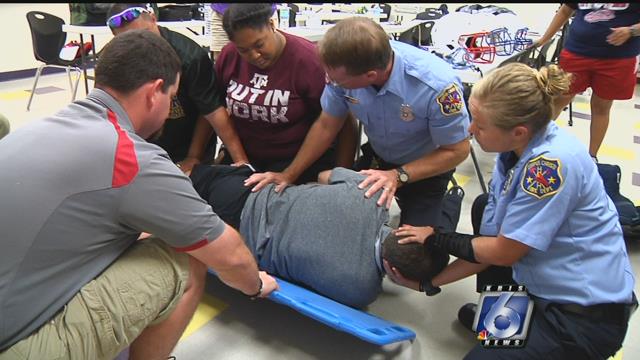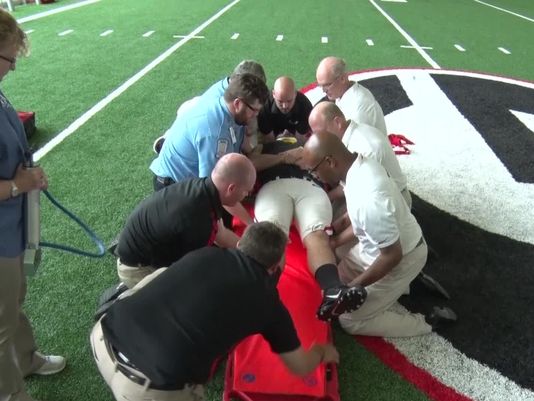
The light came on to Jason Carruth during a murky emergency situation at a Conway Christian football game.
A player lay on the ground with a possible spinal injury.
Initially, the situation seemed to require the removal of a helmet and pads.
Carruth, an athletic trainer for Conway Regional Therapy Center who also serves as athletic trainer for CCS, rushed onto the field along with first-responders from the Conway Fire Department. Carruth began working on the facemask but encountered complications with rust on some of the parts of the helmet on the rainy night.
Fortunately for the player, removal of the helmet and a trip to the emergency room was not needed.
“The first-responders asked me about what would have happened if the helmet needed to go off right away. They told me they needed to learn that,” Carruth said.
He decided on a proactive strike, especially with new guidelines for treatment of possible spinal injuries soon coming down from the National Athletic Trainers Association (NATA).
Early this month, Carruth assembled EMTs. first-responders, local athletic trainers and firefighters for a discussion/brainstorming session about the new procedures.
“We’re all doing most of the same things but some things were a little different in how we worked these situations,” Carruth said. “We needed to get as many people as possible involved in pre-hospital care of athletes in Faulkner County in one room to discuss our protocols and how we can best work together. One of the questions to ask about our different procedures was ‘why are they different?’ We needed to have that discussion in one room rather than on the football field in a critical situation.
“We felt we needed everyone to get on the same page so everyone can do what they do and know best to give the best quality treatment to an injured athlete. Ninety-five percent of what we do is in line with one another. Any differences are because MEMS and the Conway Fire Department deal with all sorts of injuries, while the NATA guidelines were developed specifically for athletic injuries.”
During football season, Conway Regional Therapy Center athletic trainers provide coverage for the majority of the area high schools in Faulkner and Perry counties.
Athletic trainers from the University of Central Arkansas and Hendrix College also attended the brainstorming session.
That meeting and exchange of the whys and wherefores of procedures has led to a series of training sessions among athletic trainers, first-responders and medical personnel on the safest ways for removing football equipment during an emergency.
“I feel the most significant thing to come out of the meeting was the collaboration of all of the first responders in the community,” said Laura Boyd, head athletic trainer at Hendrix College. “In my 10 years at Hendrix, we’ve never all gotten together for a discussion like this, and I think that is very important and beneficial for everyone involved.”
Major Melanie Reynolds with MEMS said, “It’s important, when you have multiple agencies playing different roles, that all of the tiniest details are ironed out prior to any emergent event so that the athlete can have the best possible outcome.”
The NATA is changing its guidelines to recommend removal of the helmet and equipment, if possible, before the athlete is taken to the hospital.
“That will save valuable time for treatment in the emergency room,” Carruth said. “The medical personnel can go right to work rather than trying to figure out how to get the equipment off. It is also better to get the equipment safely off in a wide-open space of a football field rather than on a guerney in the contained space of an emergecy room.
“Athletic trainers work with equipment and understand how to remove it. We also know the athletes. Sometimes, they have special equipment along with the helmets and pads. On any time in an emergency room, there may be people with various experience on equipment removal. We don’t want them have to get in a corner and ask, ‘what’s this?’”
The complication with helmet removal in a spinal injury case involves the shoulder pads and additional equipment.
“First-responders are familiar with removing a helmet in motorcycle accidents,” Carruth added. “The problem with a football player is when the helmet goes off, the head immediately goes down because of the shoulder pads. Due to possible spinal injuries, you need to restrict movement of the head.
“It takes four people to safely and properly remove a helmet and pads. So, the athletic trainers have to have help from the first-responders. They all have to understand the procedures and work together. The helmet and shoulder pads must be removed in sync and everyone must understand what they are doing.
“Usually, there is about seven minutes between the injury and when the ambulance arrives is ready for transportation to the hospital. We are waiting, anyway, so we can do something. Getting the equipment off can save valuable time in the emergency room so doctors and medical personnel can go right to work addressing the injury. Time is important. Plus, if for some reason, we can’t or shouldn’t remove the helmet on the field, the athletic trainer can ride in the ambulance and be ready to help the medical team at the hospital with removal.”
Amanda Irby, director of the Emergency Department at Conway Regional Medical Center, added, “Pre-hospital removal of the sports equipment will allow our staff to focus on the athletes injuries upon arrival instead of worrying with equipment removal. This change should expedite overall care of the traumatically injured athlete.”
The training relates to a procedure no one wants to use.
“Since 2001, I have faced such an emergency three tines,” Carruth said. “Even if you never have to use the procedure, you have to be prepared. To be honest, when I first started talking about this to various people involved, I expected some pushback, but everyone involved has been very supportive. It’s been extremely valuable in the discussion that people are looking at various possible situations and asking, ‘what if?’ We plan to meet every year to discuss procedures. We all have each other’s cell numbers and we know who to call when situations arise.”
Emergency Action Plans developed by the athletic trainers will be placed on the ambulances that serve their area so that responding crews will have access to information such as maps of the campuses and names of athletic trainers, physicians and administrators on site.
“The important thing is everyone understanding our role as a team to work together for the benefit of the athlete. It’s five or six folks working as one team,” Carruth said.
ORIGINAL ARTICLE:
http://thecabin.net/news/2015-07-24/new-procedures-putting-athletic-trainers-first-responders-same-page-sports-spinal#.VbMLW2RViko


